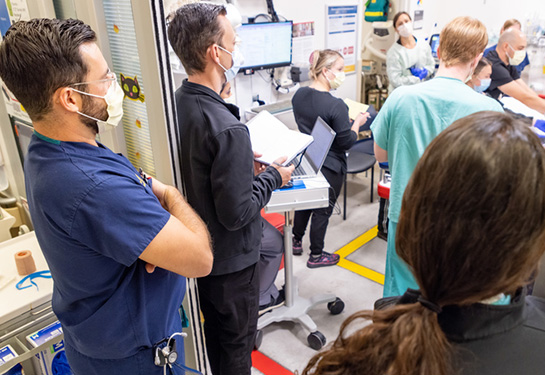NIH awards emergency medicine physicians two grants
UC Davis Health’s Department of Emergency Medicine has been awarded two National Institutes of Health (NIH) grants totaling over $5 million to improve emergency patient care.
The first grant will support a study on the use of ultrasound in the evaluation of pediatric trauma patients. The second grant will establish a new 'hub' site within the SIREN (Strategies to Innovate EmeRgENcy Care Clinical Trials) network. The goal is to identify effective treatments given in the earliest stages of emergency care.
“It is an incredible honor for our emergency department to receive these two grants, which will help fuel innovation to improve the health of acutely ill and injured patients in our community,” said Kim Barrett, vice dean for research at the UC Davis School of Medicine. “The NIH funds some of our most exciting research and enables us to make game-changing advancements for the treatment of patients.”
Ultrasound usage in pediatric trauma
The first grant was awarded to co-principal investigators Nathan Kuppermann, chair of the Department of Emergency Medicine, and James Holmes, executive vice chair of the Department of Emergency Medicine, to perform a randomized, controlled trial to compare the rates of abdominal computed tomography (CT) scanning of children for suspected intra-abdominal injuries when they do and do not receive an ultrasound during emergency department evaluation.
According to the Centers for Disease Control and Prevention, trauma is the leading cause of death in children in the United States. Among pediatric traumatic deaths, torso trauma (intra-abdominal injuries) accounts for 30% of cases.
Currently, a CT scan is the standard for diagnosing intra-abdominal injuries. However, the procedure is associated with ionizing radiation-inducing malignancies, or cancer, at an estimated rate of one per 500 abdominal CT scans in children younger than five years of age. In adolescents, the figure is one per 600 scans.
Due to this risk, ultrasound has evolved as a diagnostic test for the evaluation for intra-abdominal injuries, however, it has been used primarily in adults. The standard abdominal ultrasound for trauma is referred to as the Focused Assessment Sonography for Trauma (FAST) examination. Advantages of the FAST exam (compared to CT) include:
- bedside availability during emergency department evaluation
- rapid (3-5 minutes) completion
- ability for repeat examinations
- lack of radiation exposure
“Some studies with adult trauma patients have shown that implementation of an emergency department evaluation strategy which includes a FAST examination improves clinical outcomes, decreases complications and hospital length of stay, abdominal CT use and hospital costs,” explained Kuppermann. “However, due to the lack of definitive evidence from studies, FAST examinations are less commonly used in emergency department evaluations of children with abdominal trauma.”
For this study, Kuppermann and Holmes plan to conduct a multicenter randomized, controlled trial of the FAST examination during the initial emergency department evaluation of children with blunt abdominal trauma. They will measure abdominal CT usage and missed intra-abdominal injury rate, which will be defined by an intra-abdominal injury diagnosed after emergency department evaluation. Secondary outcomes will include emergency department length of stay and hospitalization rate.
“Although the sensitivity of the FAST exam for intra-abdominal injuries is lower than a CT scan, as a screening test, it may decrease the need for abdominal CT in children,” Holmes said. “This will decrease abdominal CT use and will increase patient safety by decreasing the risks of radiation-induced malignancies.”
New ‘hub’ in the SIREN network
A multidisciplinary team of physicians from UC Davis Health, Stanford and UC San Francisco have been awarded a grant to make the Northern California Acute Care Research Consortium (NORCARES) a new SIREN Hub.
The Strategies to Innovate EmeRgENcy Care Clinical Trials Network (SIREN) is a clinical trials network funded by the National Institutes of Health, with a goal to improve the outcomes of patients with neurologic, cardiac, respiratory and hematologic emergencies by identifying effective treatments given in the earliest stages of care.
“These three institutions are well suited to lead a new SIREN Hub, having demonstrated broad and sustained growth in their research programs and productivity over the past 20 years with robust research infrastructure to facilitate patient enrollment into trials,” said Daniel Nishijima, vice chair for research in the Department of Emergency Medicine and co-principal investigator for the grant. “With a solid infrastructure and an innovative collaborative plan, our Hub is uniquely positioned to boost enrollment and promote equity and diversity of patient populations in SIREN trials.”
The NORCARES Hub will collaborate with and provide clinical trial support to over 30 hospitals and EMS agencies (spokes) in the Northern California and western region, drawing on large and diverse patient volumes, urban and rural geographies, and academic and community hospitals.

